THERE is a frenzied outcry in the media at the moment regarding wet markets and their alleged role in the outbreak of the current pandemic.
What is not being made clear is that there are two very different types of wet markets.
The first and most common type is the normal daily fresh food market located throughout Asia and many other parts of the developing world that are a fundamental element in domestic food supply chains.
These do not represent a serious risk and must remain open.
The second and uncommon type of wet markets are those engaged in the sale and consumption of wild and exotic species.
These are where there is a risk of disease transfer to humans and where animal welfare standards are unacceptable.
This type of wet market must be closed as a matter of the highest priority.
The origins of the wild animal wet markets in China are quite simple and logical.
Following decades of Chairman Mao’s polices in the 50’s and 60’s agricultural production collapsed across China and millions died of starvation.
When the policies were finally changed, food shortages remained critical for many years.
One of the new government initiatives introduced to improve food availability was to encourage farmers to catch, farm and sell wild animals for both home consumption and commercial markets.
Fifty years on, food is now plentiful in China but the wild animal markets have continued to be popular among a small subset of culinary adventure-seekers.
There have been a number of attempts to close these markets in recent years but many have managed to survive with some going underground.
The horror of the current pandemic will almost certainly result in their final closure.
Before we get too carried away with our condemnation of the nasty practices of foreign cultures it is instructive to consider some of the delicacies that are regarded as perfectly acceptable and in fact highly desirable by the main stream in the “sophisticated” west.
Popular dishes in highly fashionable French cuisine include frogs and snails. Many parts of the west regard rabbits as a delicacy, I certainly do. And let’s not forget the current and very trendy push towards supplementing the world’s human protein supply through the production and consumption of insects.
When people are hungry they will consider eating just about anything in order to stay alive. It’s not a matter of culture, just how hungry you are.
‘It’s not a matter of culture, just how hungry you are’
I would hazard a guess that the French discovered the culinary delights of frogs, snails and rabbits during one of the many European famines they have experienced during the last 1,000 years.
Then there are the normal Asian style wet markets which provide fresh produce daily to about half the world’s population. Much of this population does not have financial resources to enjoy the luxury of airconditioned supermarkets with paddock to plate cold chains.
The best way to get a fresh chicken under these circumstances is to have it slaughtered only a very short time before purchase which ensures it is fresh before it is taken home and cooked within a few hours.
This “just in time” perishable food supply model has been used since the beginning of civilization and allowed the successful development of large, safe, temperature sensitive food supply chains without the need for refrigeration.
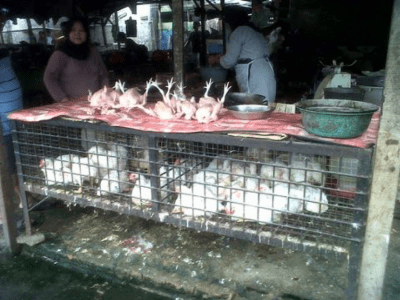
Wet market in Lampung, Indonesia. These chickens are killed on the spot only minutes before being sold which guarantees freshness with minimal time for bacterial multiplication in the tropical environment. Cooking in hot oil in a high temperature wok 3-4 hours after slaughter and purchase ensures that any bacterial contamination is nuked before consumption.
These markets would certainly benefit from a good clean up which would further improve the safe consumption times of their perishable products. This upgrading is already under way in many parts of Asia. See photo below.
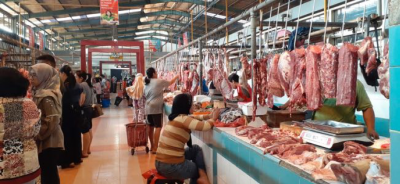
The Pasar Modern wet market in BSD City outside Jakarta. A significant upgrade to the first photo of the chicken stall in Lampung.
Across Asia, cattle are slaughtered in thousands of small abattoirs located in most cases less than 30 minutes travel from the massive number of local wet market sites.
This allows the huge populations to all receive freshly killed beef at a local market not far from their home every day of the week.
Slaughter generally commences around midnight with delivery to the market site about 3-4 am with sales beginning at 5am, ending with everything sold between 9 and 10 am. Butchers are in close communication with their wet market traders who can advise in good time if more or less animals are needed for the early morning kill. This simple process ensures that only the appropriate number of animals are slaughtered to meet the needs of the next morning’s market.
The domestic customers will take the beef home or to their food service outlet where they cook it using high temperature woks within 3 to 5 hours ending bacterial multiplication and any health risk.
The end result of these simple steps is an extremely efficient system with very little waste, no requirement for an expensive cold chain and minimal risk to human health.
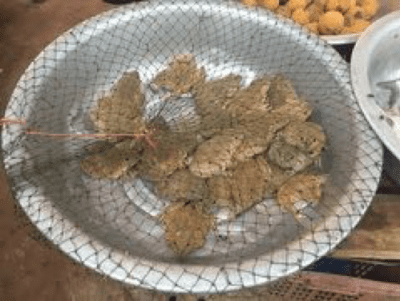
Frogs for sale in the main Vientiane wet market, Laos. No doubt an eating habit picked up from the cooking lessons provided by their previous colonial rulers, the French.
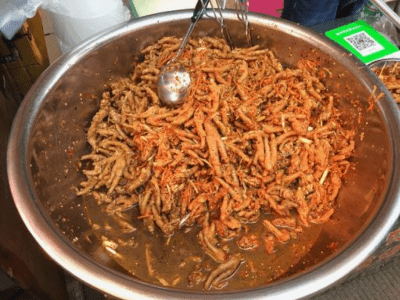
These chili chicken feet were in a wet market in Kunming, S. W. China. Chicken feet are one of my favourite dishes when eating traditional Chinese Dim Sum on a Sunday morning.
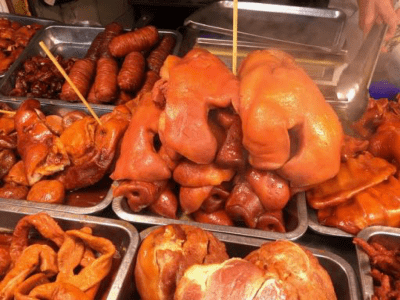
Pigs face (top centre), pigs ears (middle right), pigs hearts (bottom centre), intestine (bottom left) and goodness knows what else in the main Kunming wet market. I am sure most people would prefer to eat the prime cuts of pork but if they are not available then hungry humans innovate. As a result, they often discover that a lot of this offal is actually quite delicious.
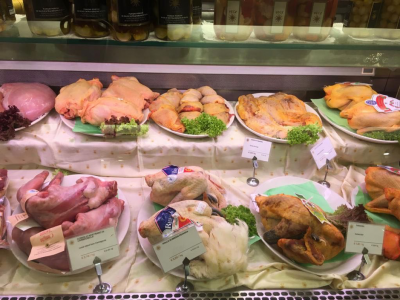
The rabbits at the bottom left of the photo from Lynette are presented in a high end delicatessen in Milan and no doubt at a very high price.
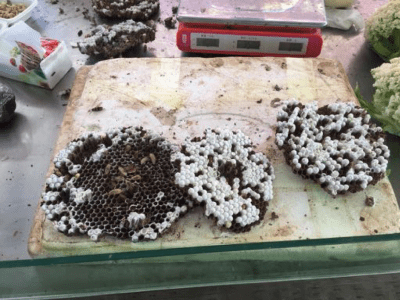
These are wasp larvae offered for sale in the main Kunming wet market. There is obviously a little bit of crossover between the true exotic animal wet markets and the main stream markets that needs to be examined for zoonotic disease risk. This particular dish would probably fall into that category.
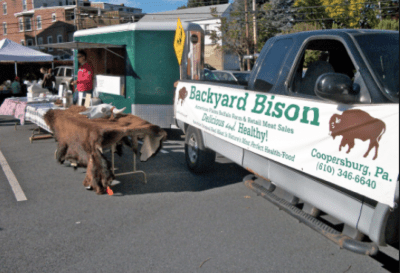
The western world sees farmers markets as a trendy novelty where the more affluent can purchase homemade foods and fresh produce direct from the farm. This is just the modern day reincarnation of the traditional wet market. In this photo from the internet, an American Bison farmer is selling his bison beef products from a mobile trailer. An exotic species too. Any need to close him down?
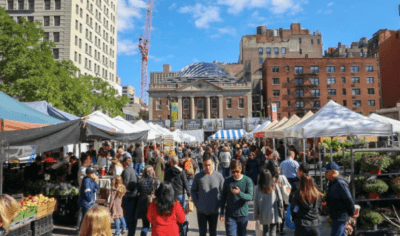
Photo from the internet : I visited this wet market (farmers market) in Union Square, central New York when I visited my daughter late last year. Fruit, vegetables, flowers, cheese, sweets, honey, wine, hot food, art, clothes etc. etc. Very popular, very expensive and not a bit of risk to anyone.

I am glad someone has made this explanation. Well written.
Normal fresh food wet markets are a traditional way of life for Asian markets. Originally due to lack of refrigeration and money to forward buy. Whilst supermarkets are coming into the regional cities of Vietnam – the prices are beyond the average household. I only shopped at the supermarkets when I wanted something imported. Many households still shop for each meal. Fresh food wet markets will never disappear.
Whereas the wild food trade should be banned for many reasons.
Whilst it will be driven underground, at least it will be reduced.
A very sensible explanation, thanks Ross. I visited a wet market in Jakarta many years ago and while some cleaning up needed to be done basically it was all OK. There are probably people in our cities who would not want to eat meat from a killer on a cattle station!! I have friends on a small block in Queensland whose niece won’t eat their eggs as they are covered in poop!! She wants the clean ones from the supermarket!!
Spot on explanation Ross.
Thanks again, Ross.
Excellent explanatory article with great photos Ross
I think you are so correct in your summation of the role of “wet markets”. In modern society we have the luxury of having fridges, etc at home as well as modern packaging (which in its self is an issue).
What I find interesting is that some of the meat (particularly red meat) is cooked and consumed pre-rigor, which will have an effect on the quality of the meat eaten, yet most of our research is focused on the primals and the effect of the ageing environment thereupon.
Another point that I find interesting is that we have good information on volumes of meat consumed in our formal marketing systems, but little is known about the volumes that go through the wet markets or consumed as bush-meat. I was also not aware that in China they actively farm with a large number of species which I automatically linked to illegal trade. Surely, when the species is farmed, it becomes easier to manage and implement the “one health” idea?
Thanks for your comment, Lourwens. We’d suggest rigor matters little, when the primary cooking method is slow-cooking in a pot. Editor